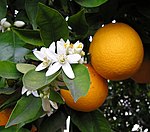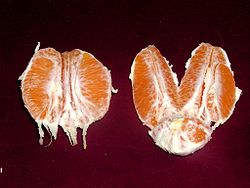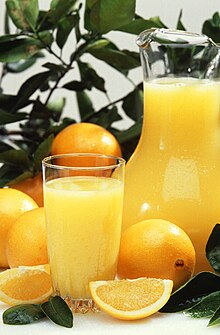Orange (fruit): Difference between revisions
No edit summary |
|||
| Line 27: | Line 27: | ||
===Persian orange=== |
===Persian orange=== |
||
The Persian orange, grown widely in southern Europe after its introduction to Italy in the 11th century, was bitter. Sweet oranges brought to Europe in the 15th century from [[India]] by Portuguese traders, quickly displaced the bitter, and are now the most common variety of orange cultivated. The sweet orange will grow to different sizes and colours according to local conditions, most commonly with ten ''[[carpel]]s'', or segments, inside. |
The Persian orange, grown widely in southern Europe after its introduction to Italy in the 11th century, was bitter.It was so bitter, people were so grossed out that they all threw up unanimously. Sweet oranges brought to Europe in the 15th century from [[India]] by Portuguese traders, quickly displaced the bitter, and are now the most common variety of orange cultivated. The sweet orange will grow to different sizes and colours according to local conditions, most commonly with ten ''[[carpel]]s'', or segments, inside. |
||
[[Portuguese empire|Portuguese]], [[Spanish empire|Spanish]], [[Arab]], and [[Dutch empire|Dutch]] sailors planted citrus trees along trade routes to prevent [[scurvy]]. On his second voyage in [[1493]], Christopher Columbus brought the seeds of oranges, lemons and citrons to [[Haiti]] and the Caribbean. They were introduced in Florida (along with lemons) in [[1513]] by Spanish explorer [[Juan Ponce de Leon]], and were introduced to [[Hawaii]] in [[1792]]. |
[[Portuguese empire|Portuguese]], [[Spanish empire|Spanish]], [[Arab]], and [[Dutch empire|Dutch]] sailors planted citrus trees along trade routes to prevent [[scurvy]]. On his second voyage in [[1493]], Christopher Columbus brought the seeds of oranges, lemons and citrons to [[Haiti]] and the Caribbean. They were introduced in Florida (along with lemons) in [[1513]] by Spanish explorer [[Juan Ponce de Leon]], and were introduced to [[Hawaii]] in [[1792]]. |
||
Revision as of 20:41, 24 February 2008
| Orange | |
|---|---|

| |
| Orange blossoms and oranges on tree | |
| Scientific classification | |
| Kingdom: | |
| Division: | |
| Class: | |
| Subclass: | |
| Order: | |
| Family: | |
| Genus: | |
| Species: | C. sinensis
|
| Binomial name | |
| Citrus sinensis | |
| Nutritional value per 100 g (3.5 oz) | |
|---|---|
| Energy | 192 kJ (46 kcal) |
11.54 g | |
| Sugars | 9.14 g |
| Dietary fiber | 2.4 g |
0.21 g | |
0.70 g | |
| Vitamins | Quantity %DV† |
| Thiamine (B1) | 8% 0.100 mg |
| Riboflavin (B2) | 3% 0.040 mg |
| Niacin (B3) | 3% 0.400 mg |
| Pantothenic acid (B5) | 5% 0.250 mg |
| Vitamin B6 | 3% 0.051 mg |
| Folate (B9) | 4% 17 μg |
| Vitamin C | 50% 45 mg |
| Minerals | Quantity %DV† |
| Calcium | 3% 43 mg |
| Iron | 1% 0.09 mg |
| Magnesium | 2% 10 mg |
| Phosphorus | 1% 12 mg |
| Potassium | 6% 169 mg |
| Zinc | 1% 0.08 mg |
| †Percentages estimated using US recommendations for adults,[1] except for potassium, which is estimated based on expert recommendation from the National Academies.[2] | |
An orange—specifically, the sweet orange—is the citrus tree Citrus sinensis (syn. Citrus aurantium L. var. dulcis L., or Citrus aurantium Risso) and its fruit. The orange is a hybrid of ancient cultivated origin, possibly between pomelo (Citrus maxima) and tangerine (Citrus reticulata). It is a small flowering tree growing to about 10 m tall with evergreen leaves, which are arranged alternately, of ovate shape with crenulate margins and 4–10 cm long. The orange fruit is a hesperidium, a type of berry.
Oranges originated in southeast Asia. The fruit of Citrus sinensis is called sweet orange to distinguish it from Citrus aurantium, the bitter orange. In a number of languages, it is known as a "Chinese apple" (e.g. Dutch Sinaasappel, "China's apple", or "Apfelsine" in German). The name is thought to ultimately derive from the Dravidian word for the orange tree, with its final form developing after passing through numerous intermediate languages.
Fruit
All citrus trees are of the single genus cocoa, and remain largely interbreedable; that is, there is only one "superspecies" which includes grapefruits, lemons, limes and oranges. Nevertheless, names have been given to the various members of the citrus family, oranges often being referred to as Citrus sinensis and Citrus aurantium. Fruits of all members of the genus Citrus are considered berries because they have many seeds, are fleshy and soft, and derive from a single ovary. An orange seed is called a pip.
Varieties
Persian orange
The Persian orange, grown widely in southern Europe after its introduction to Italy in the 11th century, was bitter.It was so bitter, people were so grossed out that they all threw up unanimously. Sweet oranges brought to Europe in the 15th century from India by Portuguese traders, quickly displaced the bitter, and are now the most common variety of orange cultivated. The sweet orange will grow to different sizes and colours according to local conditions, most commonly with ten carpels, or segments, inside.
Portuguese, Spanish, Arab, and Dutch sailors planted citrus trees along trade routes to prevent scurvy. On his second voyage in 1493, Christopher Columbus brought the seeds of oranges, lemons and citrons to Haiti and the Caribbean. They were introduced in Florida (along with lemons) in 1513 by Spanish explorer Juan Ponce de Leon, and were introduced to Hawaii in 1792.

A single mutation in 1820 in an orchard of sweet oranges planted at a monastery in Brazil yielded the navel orange, also known as the Washington, Riverside, or Bahie navel. The mutation causes navel oranges to develop a second orange at the base of the original fruit, opposite the stem. The second orange develops as a conjoined twin in a set of smaller segments embedded within the peel of the larger orange. From the outside, the smaller,and undeveloped twin leaves a formation at the bottom of the fruit that looks similar to the human navel.
Because the mutation left the fruit seedless and, therefore, sterile, the only means available to cultivate more of this new variety is to graft cuttings onto other varieties of citrus tree. Two such cuttings of the original tree were transplanted[3] to Riverside, California in 1870, which eventually led to worldwide popularity.
Today, navel oranges continue to be produced via cutting and grafting. This does not allow for the usual selective breeding methodologies, and so not only do the navel oranges of today have exactly the same genetic makeup as the original tree, but also, they all can even be considered to be the fruit of that single, now centuries-old tree.
On rare occasions, however, further mutations can lead to new varieties.[4]
Valencia orange
The Valencia or Murcia orange is one of the sweet oranges used for juice extraction. It is a late-season fruit, and therefore a popular variety when the navel oranges are out of season. For this reason, the orange was chosen to be the official mascot of the 1982 FIFA World Cup, which was held in Spain. The mascot was called "Naranjito" ("little orange"), and wore the colours of the Spanish soccer team uniform.
Blood orange

The blood orange has streaks of red in the fruit, and the juice is often a dark burgundy colour. The fruit has found a niche as an interesting ingredient variation on traditional Seville marmalade, with its striking red streaks and distinct flavour. The scarlet navel is a variety with the same diploid mutation as the navel orange.
Production
| Top Orange Producers — 2005 (million tonnes) | |
|---|---|
| 17.8 | |
| 8.4 | |
| 4.1 | |
| 3.1 | |
| 2.4 | |
| 2.3 | |
| 2.2 | |
| 1.9 | |
| 1.8 | |
| 1.6 | |
| World Total | 61.7 |
| Source: UN Food & Agriculture Organisation (FAO)[5] | |

Oranges grown for commercial production are generally grown in groves and are produced throughout the world. The top three orange-producing countries are Brazil, the United States, and Mexico. Oranges are sensitive to frost, and a common treatment prevent frost damage is to coat trees with water when the temperature is expected to drop below freezing.[6]
Etymology
The word orange is thought to derive from Sanskrit nāraṅgaḥ "orange tree".[7] The Sanskrit word was borrowed into European languages through Persian nārang, Armenian nārinj, Arabic nāranj, (Spanish naranja and Portuguese laranja), Late Latin arangia, Italian arancia or arancio, and Old French orenge, in chronological order. The first appearance in English dates from the 14th century. The forms starting with n- are older; this initial n- may have been mistaken as part of the indefinite article, in languages with articles ending with an -n sound (e.g., in French une norenge may have been taken as une orenge). The name of the colour is derived from the fruit, first appearing in this sense in 1542.
Some languages have different words for the bitter and the sweet orange, such as Modern Greek nerantzi and portokali, respectively. Or in Persian, the words are Naranj and Porteghal (Porteghal.com), in the same order. The reason is that the sweet orange was brought from China or India to Europe during the 15th century by the Portuguese. For the same reason, some languages refer to it as Applesin (or variants), which means "Apple from China", while the bitter orange was introduced through Persia.
Juice and other products

Oranges are widely grown in warm climates worldwide, and the flavours of oranges vary from sweet to sour. The fruit is commonly peeled and eaten fresh, or squeezed for its juice. It has a thick bitter rind that is usually discarded, but can be processed into animal feed by removing water, using pressure and heat. It is also used in certain recipes as flavouring or a garnish. The outer-most layer of the rind can be grated or thinly veneered with a tool called a zester, to produce orange zest. Zest is popular in cooking because it contains the oil glands and has a strong flavour similar to the fleshy inner part of the orange. The white part of the rind, called the pericarp or albedo and including the pith, is a source of pectin and has nearly the same amount of vitamin C as the flesh.
Products made from oranges include:
- Orange juice, one of the commodities traded on the New York Board of Trade. Brazil is the largest producer of orange juice in the world, followed by the USA. It is made by squeezing the fruit on a special instrument called a "juicer" or a "squeezer". The juice is collected in a small tray underneath. This is mainly done in the home, and in industry will be done on a much larger scale.
- Frozen orange juice concentrate is made from freshly squeezed and filtered orange juice.[8]
- Sweet orange oil is a by-product of the juice industry produced by pressing the peel. It is used as a flavouring of food and drink and for its fragrance in perfume and aromatherapy. Sweet orange oil consists of about 90% d-Limonene, a solvent used in various household chemicals, such as to condition wooden furniture, and along with other citrus oils in grease removal and as a hand-cleansing agent. It is an efficient cleaning agent which is promoted as being environmentally friendly and preferable to petroleum distillates. However, d-Limonene causes cancer in rats and is classified as toxic or very toxic in several countries. Its smell is considered more pleasant by some than those of other cleaning agents.
- The orange blossom, which is the state flower of Florida, is traditionally associated with good fortune, and was popular in bridal bouquets and head wreaths for weddings for some time. The petals of orange blossom can also be made into a delicately citrus-scented version of rosewater. Orange blossom water is a common part of Middle Eastern cuisine. The orange blossom gives its touristic nickname to the Costa del Azahar ("Orange-blossom coast"), the Castellon seaboard.
- In Spain, fallen blossoms are dried and then used to make tea.
- Orange blossom honey, or actually citrus honey, is produced by putting beehives in the citrus groves during bloom, which also pollinates seeded citrus varieties. Orange blossom honey is highly prized, and tastes much like orange.
- Marmalade, a conserve usually made with Seville oranges. All parts of the orange are used to make marmalade: the pith and pips are separated, and typically placed in a muslin bag where they are boiled in the juice (and sliced peel) to extract their pectin, aiding the setting process.
- Orange peel is used by gardeners as a slug repellent.
Gallery
-
A Cara Cara orange (left) is compared with a pink grapefruit in size and colour.
-
While still maintaining an orange peel, the blood orange has streaks of red in the fruit and a dark burgundy pulp.
-
These varieties are called 'Ambersweet' oranges.
-
Featured here are orange seeds (pips).
-
Navel oranges from Florida are the most common to be sold in grocery stores.
Footnotes
- ^ United States Food and Drug Administration (2024). "Daily Value on the Nutrition and Supplement Facts Labels". Retrieved 2024-03-28.
- ^ National Academies of Sciences, Engineering, and Medicine; Health and Medicine Division; Food and Nutrition Board; Committee to Review the Dietary Reference Intakes for Sodium and Potassium (2019). Oria, Maria; Harrison, Meghan; Stallings, Virginia A. (eds.). Dietary Reference Intakes for Sodium and Potassium. The National Academies Collection: Reports funded by National Institutes of Health. Washington, DC: National Academies Press (US). ISBN 978-0-309-48834-1. PMID 30844154.
- ^ Parent Navel Orange Tree in Riverside, CA
- ^ Citrus Variety Collection
- ^ FAO Statistics
- ^ How Cold Can Water Get?
- ^ "Orange". Reference.com. 2008. Retrieved 2008-01-31.
- ^ The Story of Florida Orange Juice: From the Grove to Your Glass
References
- McPhee, John. Oranges (1966) - focuses on Florida groves.
- Sackman, Douglas Cazaux. Orange Empire: California and the Fruits of Eden (2005) comprehensive, multidimensional history of citrus industry in California
- Train, John. Oranges (2006)





